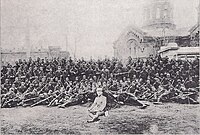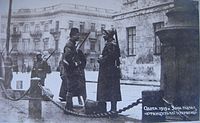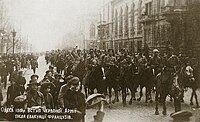Southern Russia intervention
| Southern Russia intervention | |||||||
|---|---|---|---|---|---|---|---|
| Part of the Southern Front of the Russian Civil War | |||||||
 French tanks in Odessa, 1919 | |||||||
| |||||||
| Belligerents | |||||||
|
|
(From February 18) | ||||||
| Commanders and leaders | |||||||
|
(Until February 18) |
(From February 18) | ||||||
| Strength | |||||||
|
|
Ukrainian Front in Crimea | ||||||
The Southern Russia intervention was a French-led Allied military intervention in Ukraine between December 1918 and April 1919 on the Black Sea shores of the former Russian Empire, as part of the Allied Intervention in Russia after the October Revolution. The intervention was an involvement in the Russian Civil War on the side of the White movement, but ended in failure.
Reasons behind the campaign[]
On 11 November 1918, the German Army capitulated on the Western Front, which created a vacuum in German-controlled Ukraine. Fighting broke out between Bolshevik, White Russian and Ukrainian Independist forces. French Prime-Minister Georges Clemenceau decided to send an International French-led expedition to Ukraine, to assure the retreat of the Germans, to stop the spread of Bolshevism and to establish an economic sphere of influence.
In their attempt to give the expedition an International character, the French only found a response in Greece, when Eleftherios Venizelos decided to send a sizeable contingent (the 2nd and 13th Divisions) under Major General Konstantinos Nider, aiming to gain support for Greek claims in the ongoing peace negotiations. Also some Polish, Romanian and Czech units arrived in the following months.
Command of the expedition was given to general Henri Bertholot, commander of the French Army of the Danube in Romania.
The intervention[]
The situation in Ukraine in December 1918 was very complex. There was the German-backed Hetman of Ukraine Pavlo Skoropadskyi, who had just been overthrown by the Nationalist Ukrainian People's Republic, led by Symon Petliura. Then there was the Pro-Russian White Volunteer Army led by Anton Denikin. Further there were the Bolshevik forces, which had invaded Ukraine and were marching upon Kiev. Finally, there were also a number of independent smaller armies or bands, which switched sides at their convenience.
The French landed in Odessa on 18 December 1918, in Sevastopol on 26 December, and in Nikolaev (now Mykolaiv), Kherson and Tiraspol in January 1919. In Odessa, an 7-hour battle ensued between the French and the forces of the Ukrainian People's Republic before they gained full control of the city.[2] They found a very tense situation between Petliura's Ukrainian Army and the White Volunteer Army. They were also appalled by the lack of discipline and military qualities of their Russian allies. Another unpleasant surprise was the hostile reaction of the population towards the French and especially towards the Greeks, who were seen as invaders and not as liberators. All these factors increased the war-weariness amongst the Allied troops, some of which even became susceptible to Bolshevik propaganda.
By the end of January 1919, Berthelot complained that he still had less than 3,000 soldiers to occupy all of Ukraine, and that he needed 20 divisions in total. But in the meantime, the Bolsheviks and their allies had already come to the same conclusion.
Kherson, Nikolaev and Odessa[]
A local warlord, Ataman Nikifor Grigoriev, aligned himself with the Bolsheviks on 18 February 1919 and advanced his army against the foreign invaders. With his army of 10-12,000 men, he first attacked Kherson on 2 March which was occupied by just 150 French, 700 Greek and a few hundred Volunteers of questionable reliability. After heavy fighting, the city was taken on 9 March, and the allied soldiers were evacuated by the French Fleet under cover of an intense bombardment. The allied soldiers not only had to fight the forces of Grigoriev, but had also come under sniper fire from inhabitants of the city. The French lost 4 killed and 22 wounded, while the Greeks had some 250 casualties. Local Greek residents were also killed in the aftermath.
After the conquest of Kherson, Grigorev turned his forces against Nikolaev, where there were even less allied troops present. There were still 12,000 well equipped German troops in the city, but they had no intention to participate in the fighting. The local French commander was allowed to negotiate a truce with Grigoriev, and on 14–16 March all allied and German troops were evacuated by sea without any fighting, leaving considerable quantities of war material behind.
These defeats by a disorderly and partisan band greatly undermined Allied prestige. The White force's confidence in the permanence of the Allied regime in Odessa was shaken, and the Allied troops' morale collapsed when they realised they would have to engage in fighting.[3] The morale of the French troops and the sailors of their fleet in the Black Sea was already low, and most wanted to be demobilised and sent home. The morale of the Greek and Polish interventionist forces was no better.[4]
The allies fell back on their last stronghold, Odessa, where the situation looked very grim. Although they had 25,000 soldiers in the city, the strength of Grigoriev's Army was now estimated between 30,000 and 40,000 men. The allies were outnumbered, their forces were discouraged, there was a shortage of supplies and revolution was simmering amongst the population. The Bolsheviks blockaded the city and supplies were so short that ships could not sail, meaning that ties with the outside world were now endangered.[3] Bertholot, who had asked for reinforcements several times, asked to be relieved of his command on 16 March. In the meantime, the pro-Bolshevik forces, now some 17,000 men strong, approached the city from the North, easily overrunning Berezovka (now Berezivka) on 18 March and Ochakov (now Ochakiv) a few days later. Supreme Commander of the Allied Army of the East, Franchet d'Esperey, arrived in Odessa on 20 March and quickly concluded that an evacuation was unavoidable. The situation in Odessa was tense, since all political groups in the city (with the exception of the extreme right) deplored the French actions. Representatives of the city Duma, local Mensheviks and Socialist Revolutionaries all protested against the violation of Russia's sovereignty.[5] Franchet D'Esperey asked General D'Anselme to start preparations for the evacuation, but he didn't inform the Volunteer Army nor the Greek allies. On 29 March, Franchet d'Esperey received permission from Clemenceau for the withdrawal. On 1 April Franchet d'Esperey ordered D'Anselme to execute his evacuation plan and by 6 April, all allied troops, their material and some 50,000 civilians had left the city. Not every one was evacuated over sea; a large part of the Army marched to Romania.

Greek troops in Odessa.

French colonial troops in Odessa.

The French fleet evacuating Odessa in April 1919.

Entry of Grigoriev's Army in Odessa, April 1919.
Sevastopol and the Crimea[]
Clemenceau urged Franchet d'Esperey to hold on to Sevastopol and the Crimea as a bastion for further action in Southern Russia, but the problems here were the same as in Odessa. By 14 April there were only 7,000 allied soldiers in, including 2,000 Greek and 1,500 Algerian and Senegalese troops. On 3 April, Bolshevik forces (2nd Ukrainian Soviet Army) had already easily broken through the Perekop Isthmus and were advancing quickly towards Sevastopol, reaching the outskirts of the city on 14 April. A first attack was launched upon the city on 16 April, but beaten off by artillery fire from French ships. The next day, the French asked for a truce to evacuate the city.
On 19 April a mutiny broke out on the French ships France and Jean Bart from a combination of war-weariness, Communist sympathizers in the crew, and difficult conditions. The mutiny was suppressed, but delayed the evacuation until 29 April, when the Bolsheviks entered the deserted city.
Reasons for the failure[]
The Allied intervention was a complete failure for several reasons:
- The invasion was badly organized, insufficiently supplied and ill-defined in its objectives.
- There was war-weariness among the Allied troops, who had more sympathy for the Reds than for the Whites, which even led to refusals to obey orders and mutinies.
- The population in Southern Russia was predominantly hostile to the allied troops.
- The Bolshevik military opposition was disciplined and efficient, while the White soldiers in the region were of little military value.
Aftermath[]
Allied policy turned from direct intervention to indirect aid to the White forces and a diplomatic cordon sanitaire against the Bolsheviks.
Odessa was soon retaken by the Russian White Army, but finally by the end of 1920 the Soviet Red Army managed to overpower both the Ukrainian and Russian White Army and secure Ukraine.
References[]
This article needs additional citations for verification. (January 2021) |
- ^ Kirițescu, Constantin; Istoria războiului pentru întregirea României - Ediția a III-a, vol. II; Editura Științifică și Enciclopedică, București, 1989. ISBN 973-29-0048-2
- ^ Kenez, Peter (1977). Civil War in South Russia, 1919-1920: The Defeat of the Whites. Hoover Institution on War, Revolution, and Peace. p. 182. ISBN 978-0-520-03346-7.
- ^ a b Kenez, Peter (1977-01-01). Civil War in South Russia, 1919-1920: The Defeat of the Whites. University of California Press. p. 188. ISBN 978-0-520-03346-7.
- ^ Shmelev, Anatol (2003-06-01). "The allies in Russia, 1917–20: Intervention as seen by the whites". Revolutionary Russia. 16 (1): 93–94. doi:10.1080/09546540308575766. ISSN 0954-6545. S2CID 145442425.
- ^ Kenez, p. 189
Sources[]
- Kenez, Peter (1977-01-01). Civil War in South Russia, 1919-1920: The Defeat of the Whites. University of California Press. p. 188. ISBN 978-0-520-03346-7.
- Wright, Damien. Churchill's Secret War with Lenin: British and Commonwealth Military Intervention in the Russian Civil War, 1918–20, Solihull, UK, 2017
- Shmelev, Anatol (2003-06-01). "The allies in Russia, 1917–20: Intervention as seen by the whites". Revolutionary Russia. 16 (1): 87–107. doi:10.1080/09546540308575766. ISSN 0954-6545. S2CID 145442425.
- The French army and intervention in Southern Russia, 1918–1919 by J. Kim Munholland
- Allen, W. E. D. (1963). The Ukraine: a history. Russell & Russell. p. 404. OCLC 578666051.
- Hunczak, Taras (1977). The Ukraine, 1917–1921: A Study in Revolution. Harvard University Press. p. 424. ISBN 9780674920095.
- Mawdsley, Evan (1987). The Russian Civil War. Allen & Unwin. p. 351. ISBN 9780049470248.
- Király, Béla K.; Pastor, Peter, eds. War and society in East Central Europe Vol. 20: Revolutions and interventions in Hungary and its neighbor states, 1918–1919. Columbia University Press. p. 530. ISBN 9780880331371.
- Snook, David (1989). "British Naval Operations in the Black Sea 1918–1920, Part I". Warship International. XXVI (1): 36–50. ISSN 0043-0374.
- L’intervention française à Odessa (décembre 1918 - mars 1919) vue à travers l’action du « Consul de France », Emile Henno
- 20th-century military history of France
- Wars involving Greece
- Allied intervention in the Russian Civil War
- Campaigns and theatres of World War I
- Wars involving the Soviet Union
- Conflicts in 1918
- Conflicts in 1919
- 1918 in Russia
- 1919 in Russia
- 1918 in France
- 1919 in France
- History of Odessa
- White movement
- History of Greece (1909–1924)



